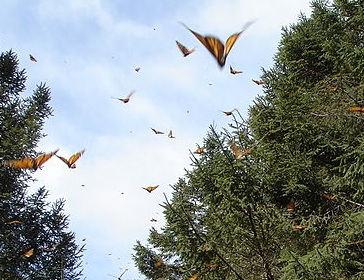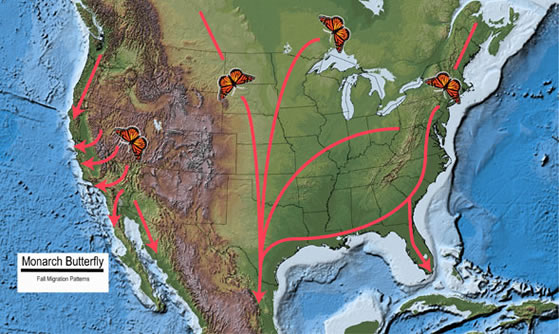The annual northward and southward migrations through Texas of millions of brilliantly hued monarch butterflies is widely celebrated as one of the most awe-inspiring phenomena of nature.
There was a double dose of bad news from Mexico and Texas about the orange-and-black monarchs this week, however.
The densely-clustered monarchs can’t be counted amid the evergreen trees of the Sierra Madre mountains, so scientists in Mexico use a key indicator, the percentage of forest areas where they winter in that nation, to estimate the size of the population. They reported that the occupied forest area this year dropped by almost 60 percent – to just 2.94 acres – from the 2011-12 season.
This was the smallest number since the first records were kept two decades ago and continued a long-term decline.
The World Wildlife Fund, which partnered with Mexican officials and others in the survey, reported:
The latest decrease in monarch butterflies is likely due to a decrease in the milkweed plant (Asclepias) – a primary food for monarchs – from herbicide use in the butterfly’s reproductive and feeding grounds in the U.S., as well as extreme climate variations during the fall and summer affecting butterfly reproduction.
“Extreme climate fluctuations in the U.S. and Canada affect the survival and reproduction of butterflies,” Omar Vidal, director general of WWF-Mexico, said. “The monarch’s lifecycle depends on the climatic conditions in the places where they develop. Eggs, larvae and pupae develop more quickly in milder conditions. Temperatures above 95°F can be lethal for larvae, and eggs dry out in hot, arid conditions, causing a drastic decrease in hatch rate.”
Meanwhile, Texas A&M University’s TAMU Times news service issued a report about the impact of continuing drought on the key part of the monarch migration that occurs in the state – moving southward in the fall and to locations north of Texas in the spring.
Craig Wilson, a senior research associate at the university who was identified as a monarch enthusiast, was quoted about the dry conditions’ effects:
“The severe drought in Texas and much of the Southwest continues to wreak havoc with the number of monarchs, Wilson explains.
“The conditions have been dry both here and in Mexico in recent years. It takes four generations of the insects to make it all of the way up to Canada, and because of lack of milkweed along the way, a lot of them just don’t make it.”
The dry conditions and changing farming practices are hampering the growth of milkweed, the only type of plant the monarch will digest as it makes its trip north. Texas has had dozens of wildfires in the past few years that have hampered milkweed growth, and even though there are more than 30 types of milkweed in the state, the numbers are not there to sustain the Monarchs as they start their 2,000-mile migration trip to Canada. Increased use of pesticides is also adversely affecting milkweed production, he notes.
The New York Times’ account of the report issued in Mexico addressed both drought and herbicide use in the U.S. as factors in the monarchs’ decline:
Warmer than usual conditions led the insects to arrive early and to nest farther north than is typical, Chip Taylor, director of the conservation group Monarch Watch at the University of Kansas, said in an interview. The early arrival disrupted the monarchs’ breeding cycle, he said, and the hot weather dried insect eggs and lowered the nectar content of the milkweed on which they feed.
That in turn weakened the butterflies and lowered the number of eggs laid.
But an equally alarming source of the decline, both Mr. Taylor and Mr. Vidal said, is the explosive increase in American farmland planted in soybean and corn genetically modified to tolerate herbicides.
The American Midwest’s corn belt is a critical feeding ground for monarchs, which once found a ready source of milkweed growing between the rows of millions of acres of soybean and corn. But the ubiquitous use of herbicide-tolerant crops has enabled farmers to wipe out the milkweed, and with it much of the butterflies’ food supply.
TAMU Times reported that Wilson is urging Texans to help the monarchs by planting mikweed in their yards:
“It is important to have a national priority of planting milkweed to assure there will be Monarchs in the future,” Wilson believes. “If we could get several states to collaborate, we might be able to provide a ‘feeding’ corridor right up to Canada for the Monarchs.”
Illegal logging in the butterflies’ protected winter habitat in Mexico, which was long believed to be a major factor in their falling numbers, has been greatly reduced, the Associated Press reported. But the AP added that Mexican officials acknowledge they continue to confront difficulties in their efforts to protect the monarchs and their migration:
The head of Mexico’s nature reserves, Luis Fueyo, said there are still some problems to be solved at the wintering grounds in Mexico, including some [small-scale] logging and water availability. The monarchs don’t drink any water throughout their long migration until the reach Mexico, and the mountain streams in the area have been affected by drought and human use.
– Bill Dawson
Image credits: Photo – Wikimedia Commons; Map – U.S. Forest Service


